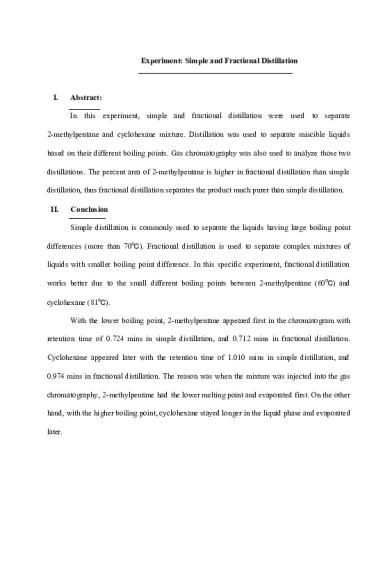Lab report simple and fractional distillation PDF

| Title | Lab report simple and fractional distillation |
|---|---|
| Author | Joseph Pham |
| Course | Organic Chemistry I* |
| Institution | Johnson County Community College |
| Pages | 3 |
| File Size | 99.8 KB |
| File Type | |
| Total Downloads | 17 |
| Total Views | 137 |
Summary
Lab report for simple and fractional distillation experiment...
Description
Experiment: Simple and Fractional Distillation
I.
Abstract: In this experiment, simple and fractional distillation were used to separate
2-methylpentane and cyclohexane mixture. Distillation was used to separate miscible liquids based on their different boiling points. Gas chromatography was also used to analyze those two distillations. The percent area of 2-methylpentane is higher in fractional distillation than simple distillation, thus fractional distillation separates the product much purer than simple distillation. II.
Conclusion Simple distillation is commonly used to separate the liquids having large boiling point
differences (more than 70℃). Fractional distillation is used to separate complex mixtures of liquids with smaller boiling point difference. In this specific experiment, fractional distillation works better due to the small different boiling points between 2-methylpentane (60℃) and cyclohexane (81℃). With the lower boiling point, 2-methylpentane appeared first in the chromatogram with retention time of 0.724 mins in simple distillation, and 0.712 mins in fractional distillation. Cyclohexane appeared later with the retention time of 1.010 mins in simple distillation, and 0.974 mins in fractional distillation. The reason was when the mixture was injected into the gas chromatography, 2-methylpentane had the lower melting point and evaporated first. On the other hand, with the higher boiling point, cyclohexane stayed longer in the liquid phase and evaporated later.
In simple distillation, the area percent of 2-methylpentane was 64.461% and 35.539% cyclohexane. When compared this numbers to the expected value (70% 2-methylpentane, 30% cyclohexane), the experimental data was lower than that. The error might happened due to the apparatus lid was not completed sealed, and some gas escaped. The temperature was increased slowly and low spinning rate was set. Thus, it took long time to wait for the 2-methylpentane evaporated and caused the error result. In order to improve the experiment, when the boiling point was reached, decreasing temperature and increasing the spinning band were required to get more product and save time. In fractional distillation, the area percent of 2-methylpentane was 80.464% and 19.536% cyclohexane. The fractional distillation contained the glass-column which caused the liquid to condense multiple time and evaporate. The 2-methylpentane with lower melting point evaporated first and moved all the way up to the top of the fractionating column. The column acted as a barrier to prevent cyclohexane from passing through. The one with higher melting point would condense on the columns and move back to the original solution. Then, the pure 2-methylpentane was collected in the receiving flask. Thus, the fractional distillation was more effective than the simple distillation, and the product would turn out much purer than the simple distillation. However, the experimental values are lower than expected value (95% 2- melthylpentane and 5% cyclohexane) due to the high set temperature of hot plate at the beginning. The mixture evaporated and condensed quickly, which made the product contained high percentage of both 2-methylpentane and cyclohexane. In order to increase the effectiveness of fractional distillation, the hot plate should be set at lower than temperature than 150℃ to make sure the liquids not boiling too fast and under the control.
III.
References 1. “The PubChem Project.” N.p., n.d. Web. 13 Mar. 2019 . . 2. Canvas: Steam distillation. 3. Donald. L. Pavia et al., Introduction to organic laboratory techniques: a microscale approach, 5th ed. Belmont: Thomson Brooks/Cole, Cengage Learning, 2013....
Similar Free PDFs

Simple Distillation Lab Report
- 9 Pages

Lab 5-Fractional Distillation
- 10 Pages

Fractional distillation
- 3 Pages

Fractional Distillation
- 4 Pages
Popular Institutions
- Tinajero National High School - Annex
- Politeknik Caltex Riau
- Yokohama City University
- SGT University
- University of Al-Qadisiyah
- Divine Word College of Vigan
- Techniek College Rotterdam
- Universidade de Santiago
- Universiti Teknologi MARA Cawangan Johor Kampus Pasir Gudang
- Poltekkes Kemenkes Yogyakarta
- Baguio City National High School
- Colegio san marcos
- preparatoria uno
- Centro de Bachillerato Tecnológico Industrial y de Servicios No. 107
- Dalian Maritime University
- Quang Trung Secondary School
- Colegio Tecnológico en Informática
- Corporación Regional de Educación Superior
- Grupo CEDVA
- Dar Al Uloom University
- Centro de Estudios Preuniversitarios de la Universidad Nacional de Ingeniería
- 上智大学
- Aakash International School, Nuna Majara
- San Felipe Neri Catholic School
- Kang Chiao International School - New Taipei City
- Misamis Occidental National High School
- Institución Educativa Escuela Normal Juan Ladrilleros
- Kolehiyo ng Pantukan
- Batanes State College
- Instituto Continental
- Sekolah Menengah Kejuruan Kesehatan Kaltara (Tarakan)
- Colegio de La Inmaculada Concepcion - Cebu











